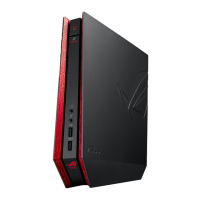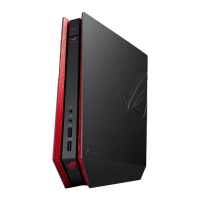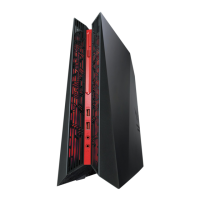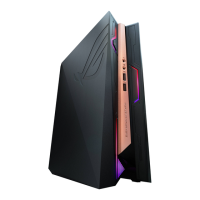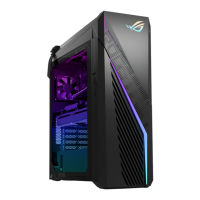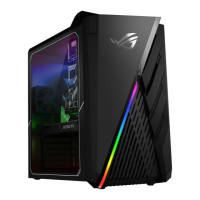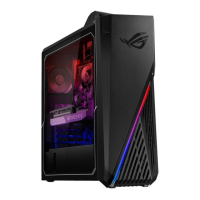Do you have a question about the Asus ROG TYTAN G30AB and is the answer not in the manual?
Welcome message and overview of the ASUS ROG TYTAN G30AB Desktop PC.
Overview of computer components, including front and rear panels.
Guide to connecting external monitors, keyboard, mouse, and power cord.
Step-by-step guide to powering on the desktop PC.
Initial setup and configuration of Windows 8 operating system.
Overview of the Windows 8 UI, including Start screen and apps.
Explains onscreen hotspots and basic navigation elements.
Instructions for launching, customizing, and closing Windows applications.
Guide to using the Charms bar and Snap feature for multitasking.
Lists useful keyboard shortcuts for navigating Windows 8.
Guide to turning PC off, sleep mode, and entering BIOS settings.
Steps to connect and remove USB storage devices safely.
Instructions for connecting microphones, headphones, and speakers.
Details on connecting the Phoebus Control Box for audio input/output.
Guide to connecting and configuring multiple monitors for extended desktop.
Instructions for connecting the computer to a High Definition TV via HDMI.
Tips for proper posture, using memory card reader, optical drive, and keyboard.
Guide for installing and using the bundled ASUS ROG U9N Gaming Keyboard.
Detailed guide on installing and customizing the ASUS GX900 Gaming Mouse features.
Steps for setting up a DSL/cable modem or LAN connection for internet access.
Guide for establishing a Wi-Fi connection to the internet via a wireless access point.
Introduction to AI Suite II and its integrated utilities for system management.
Instructions for using Probe II and Sensor Recorder for system monitoring.
Instructions for updating BIOS, using ASUS Update, Easy Update, and system recovery.
Solutions for power, display, hanging, wireless, and keyboard problems.
Addresses issues with monitors, USB devices, HDTV, audio, and DVD drives.
Detailed troubleshooting for Power, Display, LAN, Audio, System, and CPU issues from tables.
Contact details for ASUS technical support and worldwide offices.
Welcome message and overview of the ASUS ROG TYTAN G30AB Desktop PC.
Overview of computer components, including front and rear panels.
Guide to connecting external monitors, keyboard, mouse, and power cord.
Step-by-step guide to powering on the desktop PC.
Initial setup and configuration of Windows 8 operating system.
Overview of the Windows 8 UI, including Start screen and apps.
Explains onscreen hotspots and basic navigation elements.
Instructions for launching, customizing, and closing Windows applications.
Guide to using the Charms bar and Snap feature for multitasking.
Lists useful keyboard shortcuts for navigating Windows 8.
Guide to turning PC off, sleep mode, and entering BIOS settings.
Steps to connect and remove USB storage devices safely.
Instructions for connecting microphones, headphones, and speakers.
Details on connecting the Phoebus Control Box for audio input/output.
Guide to connecting and configuring multiple monitors for extended desktop.
Instructions for connecting the computer to a High Definition TV via HDMI.
Tips for proper posture, using memory card reader, optical drive, and keyboard.
Guide for installing and using the bundled ASUS ROG U9N Gaming Keyboard.
Detailed guide on installing and customizing the ASUS GX900 Gaming Mouse features.
Steps for setting up a DSL/cable modem or LAN connection for internet access.
Guide for establishing a Wi-Fi connection to the internet via a wireless access point.
Introduction to AI Suite II and its integrated utilities for system management.
Instructions for using Probe II and Sensor Recorder for system monitoring.
Instructions for updating BIOS, using ASUS Update, Easy Update, and system recovery.
Solutions for power, display, hanging, wireless, and keyboard problems.
Addresses issues with monitors, USB devices, HDTV, audio, and DVD drives.
Detailed troubleshooting for Power, Display, LAN, Audio, System, and CPU issues from tables.
Contact details for ASUS technical support and worldwide offices.
| Tcase | 72.72 °C |
|---|---|
| Bus type | QPI |
| Stepping | C0 |
| Processor cache | 8 MB |
| Processor cores | 4 |
| Processor model | i7-4770K |
| System bus rate | - GT/s |
| Processor family | Intel® Core™ i7 |
| Processor series | Intel Core i7-4700 Desktop series |
| Processor socket | LGA 1150 (Socket H3) |
| Processor threads | 8 |
| Processor codename | Haswell |
| Processor frequency | 3.5 GHz |
| Processor cache type | Smart Cache |
| Processor lithography | 22 nm |
| Processor manufacturer | Intel |
| Processor front side bus | - MHz |
| PCI Express slots version | 3.0 |
| Processor boost frequency | 3.9 GHz |
| Processor operating modes | 64-bit |
| ECC supported by processor | No |
| PCI Express configurations | 1x16, 2x8, 1x8+2x4 |
| Thermal Design Power (TDP) | 84 W |
| Number of processors installed | 1 |
| Maximum number of PCI Express lanes | 16 |
| Memory types supported by processor | DDR3-SDRAM |
| Memory clock speeds supported by processor | 1333, 1600 MHz |
| Memory bandwidth supported by processor (max) | 25.6 GB/s |
| Maximum internal memory supported by processor | 32 GB |
| Non-ECC | Yes |
| Memory slots | 4x DIMM |
| Internal memory | 16 GB |
| Memory channels | Dual-channel |
| Memory clock speed | 1600 MHz |
| Memory layout (slots x size) | - GB |
| HDD speed | 7200 RPM |
| HDD capacity | 1000 GB |
| SSD capacity | 128 GB |
| HDD interface | SATA III |
| SSD interface | The type of interface(s) with which the Solid State Drive is connected to other hardware. |
| Storage media | HDD+SSD |
| Optical drive type | DVD Super Multi |
| Total storage capacity | 1128 GB |
| Compatible memory cards | CF, Memory Stick (MS), MicroDrive, MicroSD (TransFlash), MiniSD, MMC, MS Duo, MS Micro (M2), MS PRO, MS PRO Duo, RS-MMC, SD, SDHC |
| Number of storage drives installed | 2 |
| On-board graphics card ID | 0x412 |
| Discrete graphics card model | NVIDIA® GeForce® GTX 770 |
| On-board graphics card model | Intel® HD Graphics 4600 |
| Discrete graphics card memory | 2048 GB |
| Discrete graphics memory type | GDDR5 |
| On-board graphics card family | Intel® HD Graphics |
| Maximum on-board graphics card memory | 1.74 GB |
| On-board graphics card base frequency | 350 MHz |
| On-board graphics card DirectX version | 11.1 |
| On-board graphics card dynamic frequency (max) | 1250 MHz |
| Number of displays supported (on-board graphics) | 3 |
| Operating system installed | Windows 8 |
| Ethernet LAN data rates | 100, 1000 Mbit/s |
| USB 2.0 ports quantity | USB 2.0 ports have a data transmission speed of 480 Mbps, and are backwards compatible with USB 1.1 ports. You can connect all kinds of peripheral devices to them. |
| USB 3.2 Gen 1 (3.1 Gen 1) Type-A ports quantity | 6 |
| Chassis type | Tower |
| Product color | Black |
| Water cooling system | - |
| Audio system | SonicMaster |
| Product type | PC |
| Motherboard chipset | Intel® Z87 |
| Audio output channels | 7.1 channels |
| Scalability | 1S |
| Processor code | SR147 |
| Processor ARK ID | 75123 |
| Processor package size | 37.5 x 37.5 mm |
| Supported instruction sets | AVX 2.0, SSE4.1, SSE4.2 |
| Thermal solution specification | PCG 2013D |
| Intel Identity Protection Technology version | 1.00 |
| Intel Stable Image Platform Program (SIPP) version | 0.00 |
| Power supply | 700 W |
| Sustainability certificates | ENERGY STAR |
| Depth | 544 mm |
|---|---|
| Width | 216 mm |
| Height | 481 mm |
| Weight | 14360 g |
